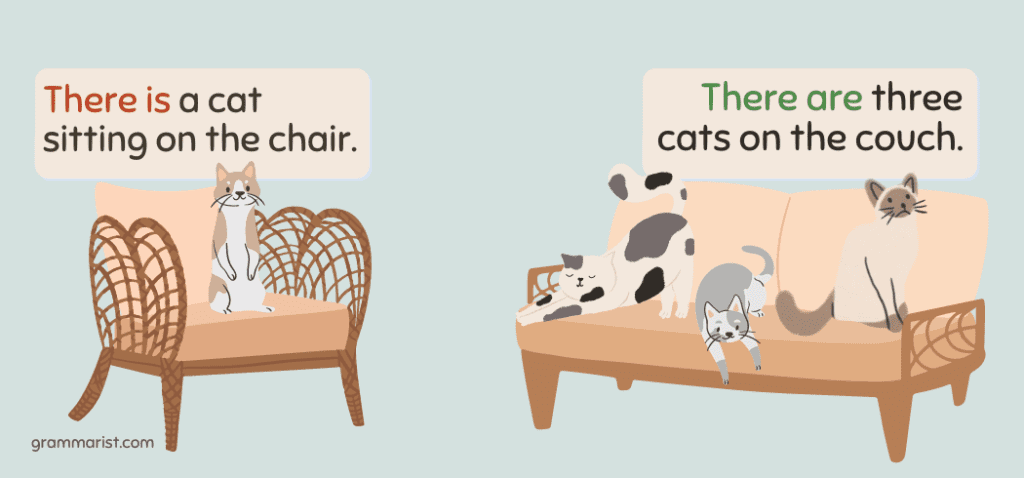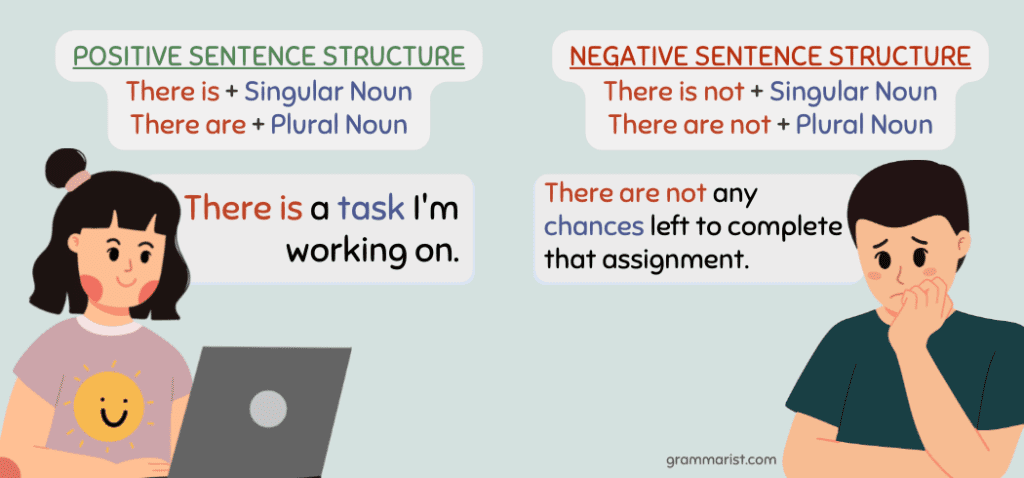The phrases “there is” and “there are” indicate that something exists. However, where it is placed in a sentence can create confusion about which form to use.
The trick to knowing how to use them correctly lies in the noun that follows it and whether it is singular or plural.
We’ve provided some very simple rules and examples below to help you correctly use “there is” and “there are” in your sentences. Be sure to test your knowledge with the included worksheet!
What Is the Difference Between “There Is” and “There Are”?

The phrases “there are” and “there is” are used to explain that something (a person, place, or thing) exists. Choosing which phrase to use is determined by the noun that follows it.
- Choose “there is” when the noun that follows it is singular.
- Choose “there are” when the noun that follows it is plural.
Singular Noun Use
A singular noun means there is only one item. To explain there is only one of something, use “there is.”
For example:
- There is a cat sitting in the middle of the driveway.
- There is only one week left before we leave for vacation!
Plural Noun Use
A plural noun means there are two or more items. To explain there is more than one of something, use “there are.”
For example:
- There are three cans of soup left in the pantry.
- Are you sure there are only two weeks of school left?
Grammar Rules When Using “There Is” or “There Are”

There are very specific grammar rules to follow when applying the phrase “there is” or “there are” to your writing. In order to ensure your writing is understood, simply follow these simple rules when saying something exists.
Positive Sentence Structure
A positive sentence structure always follows the same sentence patterns: there is + singular noun, or there are + plural noun.
For example:
- There is a computer sitting on the desk.
- There are computers in the lab for student use.
An uncountable noun always uses “there is.” Uncountable nouns are things we cannot count with numbers (such as foods, feelings, ideas, weather, or collective nouns).
For example:
- There is some stormy weather in the forecast.
- There is clothing in the dryer that needs folding.
- There is hesitancy concerning signing up for the weekend retreat.
Negative Sentence Structure
A negative sentence structure includes the word not after “is” and “are.” This follows the same pattern as above: There is not + singular noun or there are not + plural noun.
Negative sentences that include uncountable nouns always use “there is not.”
For example:
- There is not a single thing I can say to change her mind.
- There are not any chances left to complete that assignment.
- There is not any machinery available for rent this weekend.
The negative sentence structure form sounds better when used with contractions, however. This is discussed below.
Using Contractions
Contractions are made by combining two words into one. They are generally informal but can help create flow and ease of speech. An apostrophe is used to replace the letters removed from a word to form a contraction.
The contraction of “there is” is “there’s.”
For example:
- There’s a rumor going around that we are taking a cruise for our Senior Trip.
- There’s only one more appointment available for Saturday morning.
“There are” cannot be used as a contraction.
Isn’t vs. Aren’t
Negative sentence structures usually sound better with contractions.
The contraction of “there is not” is “there isn’t.”
For example:
- There isn’t a way out of the city on this road.
- There isn’t a way to convince my teacher to accept late work.
The contraction of “there are not” is “there aren’t.”
For example:
- There aren’t any popsicles in the freezer.
- There aren’t any more days left in the week.
Interrogative Sentence Structure
To ask a question using “there is” or “there are” at the beginning of a sentence, you simply switch the words around to read “is there” or “are there,” followed by the rest of the question. They still refer to singular and plural nouns, respectively.
For example:
- Is there any milk left in the refrigerator, or must I go to the store today?
- Are there any questions about the essay assignment?
Sentences That Begin With “How Many”
How many is often used with the plural phrase “there are.” When a sentence begins with “how many,” you change “there are” to “are there” using the following word structure:
How many + plural noun + are there
You do not use “how many” with “there is.”
For example:
- How many homework assignments are there this semester?
- How many pumpkins are there to carve?
- How many days are there during winter break?
Using Collective Nouns
Collective nouns are treated as singular nouns but describe plural nouns. Now what?
Technically you should use “there is” with a collective noun, but sometimes this sounds awkward and makes your writing sound weaker. In this situation, you need to stick with what sounds correct. Let’s look at a few examples of this.
Collective nouns with “there is”
Correct:
- There is a collection of dolls in the museum I think you would like.
- There is an assortment of candies available for Halloween.
Awkward:
- There are a collection of dolls in the museum I think you would like.
- There are an assortment of candies available for Halloween.
Collective nouns with “there are”
Correct:
- There are a variety of different wedding dresses on the hangers for you to try on.
- There are a number of ways you could have solved that problem if you had only asked.
Awkward:
- There is a variety of different wedding dresses on the hangers for you to try on.
- There is a number of ways you could have solved that problem if you had only asked.
Let’s Review
When describing a singular subject, use “there is.” When describing plural nouns, use “there are.” Uncountable nouns also always use “there is.”
The same rules are applied whether you are using contractions or a positive or negative sentence structure. The only time you can break free from these constrictions is with collective nouns. In this case, use whichever one doesn’t sound awkward.